Last year, the White House published a blog post titled “As the US Consumer Goes, So Goes the US Economy.”
No matter what your politics are, I think we can all agree that America’s economy depends on consumers buying things. For us income investors, then, the consumer’s health is a key thing to watch, as it ultimately sets the direction of stocks.
So how healthy is the US consumer today, and can we confidently buy stocks—and better still, high-yielding CEFs like the one we’ll talk about below (current yield: 10%)?
Often, the signals are murky. America is, after all, a big country with a lot of people in it, and some of those people are obviously doing better than others, so it’s tricky to zero in on the overall health of consumers.
Still, there are some things every consumer is sensitive to and, ultimately, will affect everyone’s spending. The biggest variable, as you can likely guess, is inflation.
High Inflation = Steep Selloffs
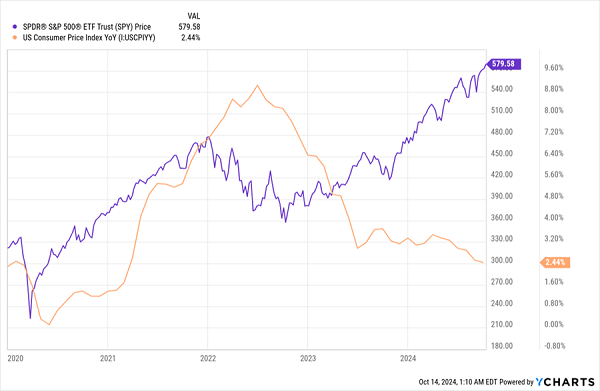
In 2021, as we all know well, inflation, as measured by the consumer price index (in orange above) started climbing. That caused stocks to tank in 2022, as spiraling prices of everyday things forced pretty well everyone, no matter how rich, to cut back to varying degrees.
But see how the orange line kept going down? The CPI is now back around pre-pandemic levels. With that in mind, you’d expect US consumers to boost their spending again. And they have.
More Spending on Fun
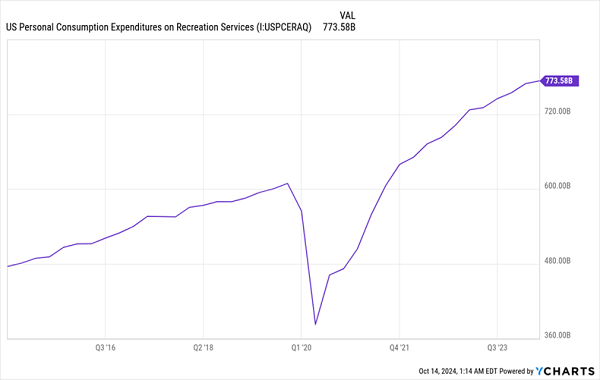
This is an obscure metric, but it’s important: how much Americans spend on recreation services (think movie tickets, concerts, hotels, amusement parks and such).
After the pandemic slump, inflation slowed the recovery to the pre-pandemic trendline in 2021 and 2022. Growth recovered in 2023 and has kept strengthening so far in 2024. In short, Americans have more money to spend on fun because 2022’s inflationary pressures have started to ebb.
Here’s another interesting chart on the health of the consumer:

Source: Apollo Global Management
What this shows us is that, if you take the average US household and count up its debt, the total amounts to less than 100% of their disposable (or after-tax) income.
In other words, putting 100% of that income toward their debt could erase their borrowings in less than a year (which is obviously impossible but useful for context here). Contrast that with other wealthy nations, like Canada and Australia, where households would need a year and 10 months.
Combine healthy US household balance sheets and higher spending on recreation and it’s hard to conclude that, generally speaking, the US consumer is anything but healthy.
How to Profit
A strong consumer means a strong economy and strong corporate earnings. That, in turn, translates to larger returns to shareholders in the form of buybacks and dividends.
A Rising Tide of S&P 500 Dividends and Buybacks
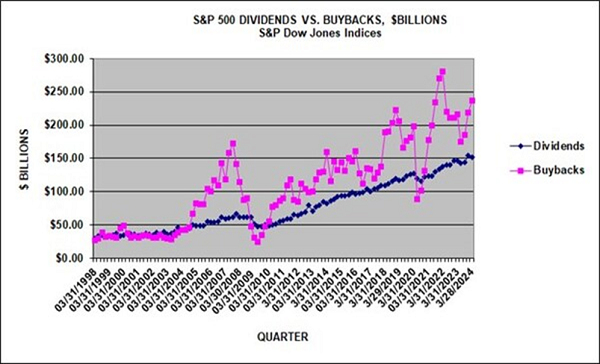
Source: S&P 500
In 2023, S&P 500 firms spent over $800 billion buying back shares from investors, while giving them over $500 billion in cash dividends.
You can be one of the people getting a “paycheck” from companies like Apple (AAPL), Microsoft (MSFT) and Visa (V) when you invest in an index fund like the SPDR S&P 500 ETF Trust (SPY). But don’t expect that to turn into a big cash flow overnight.
With SPY yielding just 1.2%, even a million dollars in this fund won’t replace more than $1,000 per month in income—hardly a living wage! But we can speed that up without sacrificing quality if we instead buy a fund like the Liberty All-Star Equity Fund (USA), one of my favorite closed-end funds (CEFs).
USA invests in US mid-cap and large-cap firms: Its portfolio holds Apple, Microsoft, Visa and many other top S&P 500 names. While its holdings resemble those of SPY, its dividend does not.
USA turns gains and dividends from the stocks it holds into an income stream for investors, which is how it can pay out a far bigger dividend than SPY: 10%, to be exact. Based on USA’s yield (note that its payout does fluctuate a bit, based on the fund’s portfolio returns), a million-dollar portfolio now pays $8,333 averaged out on a monthly basis—higher than the average American’s paycheck.
But will the income stream hold? A 10% yield seems unrealistically high, which is why a lot of people scoff when I show them facts like these. So let’s look at history.
Big Payouts Rising With the Market
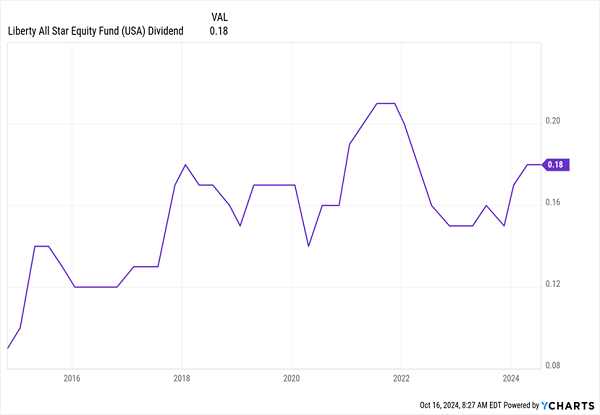
USA’s payout has steadily risen with the stock market over the last decade. As long as consumers have money to spend, giving companies revenue they can translate into profits for their shareholders, USA will be able to pump that dividend number up further.
Finally, let’s talk about USA’s discount to net asset value (NAV, or the value of the fund’s underlying portfolio).
As I write this, the fund trades just a hair over par. While we prefer discounted CEFs, that’s reasonable for USA, given its strong management and outsized yield. We’ve also seen the fund trade at healthy premiums (north of 4%) as recently as July 2023.
USA’s Premium Is Actually Low Compared to Recent Peaks
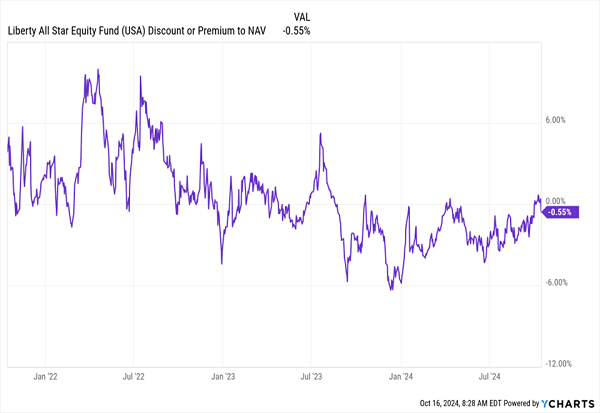
Nonetheless, if you prefer to buy at a discount, I get it. In that case, go ahead and put USA on your watch list. Given the fund’s very slight premium, it wouldn’t take much to push it back into discount territory.
Huge 9.8% Dividends From … AI?!
Few people realize it, but CEFs are the only way to invest in AI’s continued growth and get a fat dividend yield in return.
Individual stocks? They just don’t cut it: AI poster boys like NVIDIA (NVDA), Microsoft and the like yield next to nothing.
That’s NOT the case with the 4 “AI-Powered” CEFs I’m pounding the table on now. They yield a fat 9.8% on average today and they’re ALL cheap—so much so that they essentially let us buy the AI stocks in their portfolios at prices that haven’t been available to “regular” investors for months.
Now is the time to buy these 4 impressive funds and start reaping big profits (and dividends) as AI continues to embed itself in our day-to-day lives.
